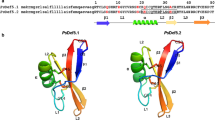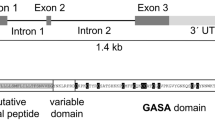Abstract
The putative plant defensin SPI1 cDNA from the conifer Norway spruce (Picea abies) is the only known plant defensin-like sequence from a gymnosperm. The predicted translational product SPI1 was not detected in the embryo or other parts of the seed by means of antibodies, but it accumulated in the root cortex after germination. In roots of seedlings infected with the root pathogenic oomycete Pythium dimorphum and the blue stain fungus Ceratocystis polonica, variable levels of SPI1 was detected during the first day as a response to the infection, however a significant increase was seen as an initial response to the root-rot fungus Heterobasidion annosum. After the first day of infection, the amount of SPI1 polypeptide was dramatically reduced in response to either of the pathogens, but not in response to the ectomycorrhizal fungus Laccaria bicolor. During the same time of infection, extensive damage to cortical root cells resulted from the infecting pathogens, but not from the mycorrhiza. These results indicate that pathogens may reduce the level of SPI1 by suppressing its expression, but may also reduce the SPI1 level by invading and disrupting the root cortical cells or by a combination of these mechanisms.
Similar content being viewed by others
References
Asiegbu, F.O., Daniel, G. and Johansson, M. 1994. Defense-related reactions of seedling roots of Norway spruce to infection by Heterobasidion annosum (Fr.) Bref. Physiol. Mol. Plant Path. 45: 1–19.
Asiegbu, F.O., Denekamp, M., Daniel, G. and Johansson, M. 1995. Immunocytochemical localization of pathogenesis-related proteins in roots of Norway spruce infected with Heterobasidion annosum. Eur. J. Forest Path. 25: 169–178.
Ausubel, F.M., Brent, R., Kingston, R.E., Moore, D.D., Seidman J.G., Smith, J.A. and Struhl, K. eds. 1987. Current Protocols in Molecular Biology. John Wiley, New York.
Broekaert, W.F., Terras, F.R.G., Cammune, B.P.A. and Osborn, R.W. 1995. Plant defensins: novel antimicrobial peptides as components of the host defense system. Plant Physiol. 108: 1353–1358.
Børja, I., Sharma, P., Krekling, T. and Lönneborg, A. 1995. Cytopathological response in roots of Picea abies seedlings infected with Pythium dimorphum. Phytopathology 85: 495–501.
Christiansen, E. and Solheim, H. 1990. The bark beetle-associated blue-stain fungus Ophiostoma polonicum can kill various spruces and Douglas fir. Eur. J. Forest Path. 20: 436–446.
Dixon, R.A. and Harrison, M.J. 1990. Activation, structure, and organization of genes involved in microbial defense in plants. Adv. Genet. 28: 165–234.
Elfstrand, M., Fossdal, C.G., Swedjemark, G., Clapham, D., Olsson, O., Sitbon, F., Sharma, P., Lönneborg, A. and von Arnold, S. 2001. Identification of candidate genes for use in molecular breeding: a case study with the Norway spruce defensin-like gene, SPI1. Silvae Genet. 50: 75–81.
Eltrop, L. and Marschner, H. 1996. Growth and mineral nutrition of non-mycorrhizal and mycorrhizal Norway spruce (Picea abies) seedlings grown in semi-hydroponic sand culture. I. Growth and mineral nutrient uptake in plants supplied with different forms of nitrogen. New Phytol. 133: 469–478.
Ekramoddoullah, A.K and Davidson, J.J. 1995. A method for the determination of conifer foliage protein extracted using sodium dodecyl sulphate and mercaptoethanol. Phytochem. Anal. 6: 20–24.
Epple, P., Apel, K., and Bohlmann, H., 1997. ESTs reveal a multigene family for plant defensins in Arabidopsis thaliana. FEBS Lett. 400: 168–172.
Fossdal, C.G. 1999. Molecular and cytological responses in rootinfected Norway spruce [Picea abies (L.) Karst.] seedlings. Ph.D. Dissertation, Agricultural University of Norway, Ås, Norway.
Fossdal, C.G., Sharma, P. and Lönneborg, A. 2001. Isolation of the first putative plant peroxidase cDNA from a conifer and the local and systemic accumulation of related proteins upon pathogen infection. Plant Mol. Biol. 47: 423–435.
Gu, Q., Kamata, E.E., Morse, M.J., Wu, H.M. and Cheung, A.Y. 1992. A flower-specific cDNA encoding a novel thionin in tobacco. Mol. Gen. Genet. 234: 89–96.
Karabaghli-Degron, C., Sotta, B., Bonnet, M., Gay, G. and LeTacon, F. 1998. The auxin transport inhibitor 2,3,5-triiodobenzoic acid (TIBA) inhibits the stimulation of in vitro lateral root formation and the colonization of the tap-root cortex of Norway spruce (Picea abies) seedlings by the ectomycorrhizal fungus Laccaria bicolor. New Phytol. 140: 723–733.
Kozlowski, G. and Metraux, J.P. 1998. Infection of Norway spruce (Picea abies (L.) Karst.) seedlings with Pythium irregulare Buism. and Pythium ultimum Trow: histological and biochemicalresponses. Eur. J. Plant Path. 104: 225–234.
Kozlowski, G., Buchala, A. and Metraux, J.P. 1999. Methyl jasmonate protects Norway spruce (Picea abies (L.) Karst.) seedlings against Pythium ultimum Trow. Physiol. Mol. Plant Path. 55: 53–58.
Kristensen, A.K., Brunstedt, J., Nielsen, J.E., Mikkelsen, J.D., Roepstorff, P. and Nielsen, K.K. 1999. Processing, disulfide pattern, and biological activity of a sugar beet defensin, AX2, expressed in Pichia pastoris. Protein Expr. Purif. 16: 377–387.
Lönneborg, A. and Jensen, M. 2000. Reliable and reproducible method to extract high-quality RNA from plant tissues rich in secondary metabolites. Biotechniques 29: 714–718.
Manners, J.M., Penninckx, I.A., Vermaere, K., Kazan, K., Brown, R.L., Morgan, A., Maclean, D.J., Curtis, M.D., Cammue, B.P. and Broekaert, W.F. 1998. The promoter of the plant defensin gene PDF1.2 from Arabidopsis is systemically activated by fungal athogens and responds to methyl jasmonate but not to salicylic acid. Plant. Mol. Biol. 8: 1071–1080.
Menedez, E., Moreno, A., Collila, F., Pelaez, F., Limas, G.G., Mendez, R., Soriano, F., Salinas, M. and DeHaro, C. 1990. Primary structure and inhibition of protein synthesis in eukaryotic cell-free system of a novel thionin, γ-hordothionin, from barley endosperm. Eur. J. Biochem. 194: 533.
Moreno, M., Segura, A. and Garcia-Olmedo, F. 1994. Pseudothionin-ST1, a potato peptide active against potato pathogens. Eur. J. Biochem. 223: 135–139.
Nagy, N.E., Franceschi, V.R., Solheim, H., Krekling, T. and Christiansen, E. 2000. Wound-induced traumatic resin duct formation in stems of Norway spruce (Pinaceae): anatomy and cytochemical traits. Am. J. Bot. 87: 302–313.
Osborn, R.W., Desamblanx, G.W., Thevissen, K., Goderis, I., Torrekenes, S., vanLeuven, F., Attenborough, S., Rees, S.B. and Broekaert, W.F. 1995. Isolation and characterization of plant defensins from seeds of Asteracea, Fabaceae, Hippocastanaceae and Saxifragaceae. FEBS Lett. 368: 257–262.
Pappinen, A., and von Weissenberg, K. 1997. Detection and partial characterization of extracellular proteases of the pathogenic fungi Endocronartium pini, Gremmeniella abietina and Heterobasidion annosum. Eur. J. Plant Path. 27: 373–380.
Schagger, H. and von Jagow, G. 1987. Tricine sodium dodecylsulfate polyacrylamide-gel electrophoresis for the separation of proteins in the range from 1kD to 100kD. Anal. Biochem. 166: 368–379.
Segura, A., Moreno, M., Molina, A. and Garcia-Olmedo, F. 1998. Novel defensin subfamily from spinach (Spinacia oleracea). FEBS Lett. 435: 159–162.
Sharma, P. 1995. Induced defence responses in spruce (Picea abies (L.) Karst.) roots during infection with a pathogenic fungus, Pythium dimorphum. Ph.D. Dissertation, Agricultural University of Norway, Ås, Norway.
Sharma, P. and Lönneborg, A. 1996. Isolation and characterization of a cDNA encoding a plant defensin-like protein from roots of Norway spruce. Plant Mol. Biol. 3: 707–312.
Tarlton, J.F. and Knight, P.J. 1996. Comparison of reflectance and transmission densitometry, using document and laser scanners, for quantitation of stained western blots. Anal. Biochem. 237: 123–128.
Terras, F.R., Schoofs, H.M., DeBolle, M.F., vanLeuven, F., Rees, S.B., Vanderleyden, J., Cammue, B.P. and Broekaert, W.F. 1992. Analysis of 2 novel classes of plant antifungal proteins from radish seeds. J. Biol. Chem. 267: 15301–15309.
Terras, F.R., Torrekenes, S., vanLeuven, F., Osborn, R.W., Vanderleyden, J., Cammue, B.P. and Broekaert, W.F. 1993. A new family of basic cysteine-rich plant antifungal proteins from Brassicaceae species. FEBS Lett. 316: 233–240.
Terras, F.R., Eggermont, K., Kovaleva, V., Raikhel, N.V., Osborn, R.W., Kester, A., Rees, S.B., Torrekenes, S., vanLeuven, F., Vanderleyden, J., Cammue, B.P. and Broekaert, W.F. 1995. Small cysteine-rich antifungal proteins from radish: their role in host defense. Cell 7: 573–588.
Thevissen, K., Ghazi, A., DeSamblanx, G.W., Brownlee, C., Osborn, R.W. and Broekaert, W.F. 1996.Fungal membrane responses induced by plant defensins and thionins. J. Biol. Chem. 271: 15018–15025.
Thevissen, K., Osborne, R.W., Acland, D.P. and Broekaert, W.F. 1997. Specific, high affinity binding sites for an antifungal plant defensin on Neurospora crassa hyphae and microsomal membranes. J. Biol. Chem. 272: 32176–32181.
Thevissen, K., Osborn, R.W., Acland, D.P. and Broekaert, W.F. 2000. Specific binding sites for an antifungal plant defensin from dahlia (Dahlia merckii) on fungal cells are required for antifungal activity. Mol. Plant.-Microbe Interact. 13: 54–61.
Thomma, B.P. and Broekaert, W.F. 1998. Tissue-specific expression of plant defensin genes PDF2.1 and PDF2.2 in Arabidopsis thaliana. Plant Physiol. Biochem. 36: 533–537.
Vad, K., Mikkelsen J.D., and Collinge D.B., 1991. Induction, purification and characterization of chitinase isolated from pea leaves inoculated with Ascochyta pisi. Planta 184: 24–29.
van Loon, L.C. 1985. Pathogenesis related proteins. Plant Mol. Biol. 4: 111–116.
van Loon, L.C. 1998. The 5th Int. workshop on pathogenesis-related proteins in plant signaling and biological activities. In: Woodward, S., Stenlid, J., Karjalainen, R. and Hüttermann, A. (eds.). 1998. Heterobasidion annosum: Biology, Ecology, Impact and Control. CAB International, Oxford, UK, PR98 abstract L1.
Author information
Authors and Affiliations
Corresponding author
Rights and permissions
About this article
Cite this article
Fossdal, C.G., Nagy, N.E., Sharma, P. et al. The putative gymnosperm plant defensin polypeptide (SPI1) accumulates after seed germination, is not readily released, and the SPI1 levels are reduced in Pythium dimorphum-infected spruce roots. Plant Mol Biol 52, 291–302 (2003). https://doi.org/10.1023/A:1023915230129
Issue Date:
DOI: https://doi.org/10.1023/A:1023915230129




